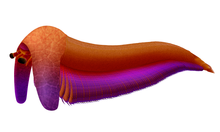| Balhuticaris Temporal range: Cambrian,
| |
|---|---|

| |
| Life restoration | |
| Scientific classification | |
| Domain: | Eukaryota |
| Kingdom: | Animalia |
| Phylum: | Arthropoda |
| Order: | †Hymenocarina |
| Genus: | †Balhuticaris Izquierdo-López & Caron, 2022 |
| Type species | |
| †Balhuticaris voltae Izquierdo-López & Caron, 2022
| |
Balhuticaris is a genus of extinct bivalved (referring to the carapace) hymenocarine arthropod that lived in the Cambrian aged Burgess Shale in what is now British Columbia around 506 million years ago. This extremely multisegmented (with over 100 segments) arthropod is the largest member of the group, and it was even one of the largest animals of the Cambrian, with individuals reaching lengths of 245 mm (9 in). Fossils of this animal suggests that gigantism occurred in more groups of Arthropoda than had been previously thought.[1] It also presents the possibility that bivalved arthropods were very diverse, and filled in a lot of ecological niches.[1][2][3]
The hymenocarines were an order of primitive mandibulates, the arthropod group that includes crustaceans, insects, myriapods and their relatives, that lived throughout the Cambrian period.[2] This group was extremely diverse and attained a wide variety of ecological niches and body plans.[2][3] Several dozen species are known from deposits of Cambrian, and ranged in size from smaller species like Fibulacaris nereidis reaching a length of 2 cm (0.79 in) long,[2] to larger ones like B. voltae.[1]
- ^ a b c Izquierdo-López, Alejandro (July 15, 2022). "Extreme multisegmentation in a giant bivalved arthropod from the Cambrian Burgess Shale". iScience. 25 (7): 104675. Bibcode:2022iSci...25j4675I. doi:10.1016/j.isci.2022.104675. PMC 9283658. PMID 35845166.
- ^ a b c d Izquierdo-López, Alejandro; Caron, Jean-Bernard (2019). "A possible case of inverted lifestyle in a new bivalved arthropod from the Burgess Shale". Royal Society Open Science. 6 (11): 191350. Bibcode:2019RSOS....691350I. doi:10.1098/rsos.191350. PMC 6894550. PMID 31827867.
- ^ a b O'Flynn, Robert; Williams, Mark; Yu, Mengxiao; Harvey, Thomas; Liu, Yu (2022-02-11). "A new euarthropod with large frontal appendages from the early Cambrian Chengjiang biota". Palaeontologia Electronica. 25: a6. doi:10.26879/1167.